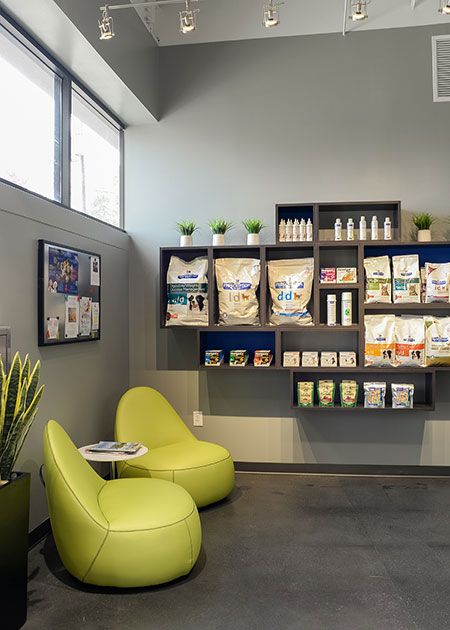How to be a veterinary practice retail guru
Is one of your veterinary hospital team members the right person to rev up your retail offerings? Or is that you? Here are my five steps to rethinking your clinics retail for happy pet owners and patients.

Reception area with retail at CityVet, an urban animal hospital, in Raleigh, North Carolina (Photo courtesy of Kevin D. Hunt).In October 2017, I went from receptionist to practice manager in a day. Our practice had sold to a new owner, and part of the transition called for me to fill the previously nonexistent role.
Included in the purchase of the practice was the inventory on the shelves, and there was a lot of it-especially retail. The problem was that most of it was dusty, discolored and irrelevant to our clientele. It was important to me to revamp the space and create something that our clients could depend on for the items they needed. By doing so, I could ensure their return to the clinic multiple times per year instead of their typical one annual visit-thus driving sales and increasing profit.
If you've been drafted-or volunteered-to manage the client-facing, retail inventory at your veterinary hospital, I've got five steps that helped me out along the way.
Are you already the retail manager?
Check out the steps in this story, then dive into more content about retail here and in the stories below:
• 4 steps to revitalize your hospital retail
• No longer an afterthought: Making your veterinary practice's retail area shine
• 3 must-have retail items for your hospital
Step 1. Clean house
If you already have retail items in your clinic, run reports on those products to determine what's selling and what's not. If it hasn't sold in the last three months, it probably won't. Mark it down and move it out. What you can't sell, donate to a local shelter or animal rescue.
Don't have a retail space, but want one? Don't worry-your retail space doesn't have to be large. Maybe you have an empty corner that could fit a small shelf. As long as it's well-organized, visible and stocked with appropriate items, it will generate revenue. Choose a space that sees a lot of foot traffic but also allows the front desk to keep an eye on it for loss prevention and restocking purposes. Consider countertop displays for your checkout area, and stock it with small items like toys and pet odor candles. These items are easy to sell to those clients looking to treat their pet (or themselves) after a successful vet visit.
Step 2. Do your research
Talk to your clients, employees, friends and family. What pet products are they purchasing at their local pet store or big-box store? Which products are your doctors recommending that you don't carry yet?
Make a list of items and then decide what will fit in the space you've created. Research pricing on those items at local pet stores and online retailers to get an idea of the average price. Markup on these items will be minimal, so it's important to price appropriately.
Step 3. Purchase and make it pretty
Talk to your vendor reps about the products you're looking for. Many reps will offer specials and buy-one-get-one-free offers to bring in new products. Educate yourself on return policies and product guarantees as well. If a dental chew comes with a 100% money-back guarantee, a client may be more motivated to give it a try.
Once you have new products in stock, get to organizing them by category and stock the shelves accordingly: nutraceuticals, dental care items, toys, grooming supplies, food, treats. Make sure each product is clearly priced and displayed neatly. If you have the space, allow one section for seasonal items to be rotated on a regular basis.
Step 4. Educate, then delegate
Your staff is already in the habit of promoting flea, tick and heartworm preventives and other hospital services. Look at your retail space as an extension of those services, and make sure your staff-especially the front desk team-is educated on the products you offer. They can't sell what they don't know.
In an ideal world, one of your team could take on the duties of a retail manager.
In an ideal world, one of your team could take on the duties of a retail manager. (Are you a team member reading this? That's you!) Maybe one of the veterinary assistants has a background in retail or one of the receptionists is exceptionally good at getting clients to purchase a full year of preventive after annual exams. Task this team member with making sure the retail space stays organized, clean and stocked.
Step 5. Monitor and motivate
The retail manager should regularly monitor inventory turnover and should be open to changing the products until the hospital finds the right ones. Partnering with reps and knowing return policies will help prevent loss and allow you to fine-tune that retail space.
The practice manager, or better yet the person taking on the duties of retail manager, can motivate the team by including retail products in sales challenges or productivity goals. As a manager, I'm always looking for a way to better track productivity from my front desk staff, and retail add-on purchases is one way to do it.
Overall, retail items are fun, so encourage everyone to have fun recommending them, talking about them and selling them to pet owners. You may grow proud of your newest profit center, even if it is just a little shelf in the corner.
Sara Karasinski is practice manager of Arrow Veterinary Clinic in Lowell, Michigan, as well as a member of the Veterinary Hospital Managers Association.